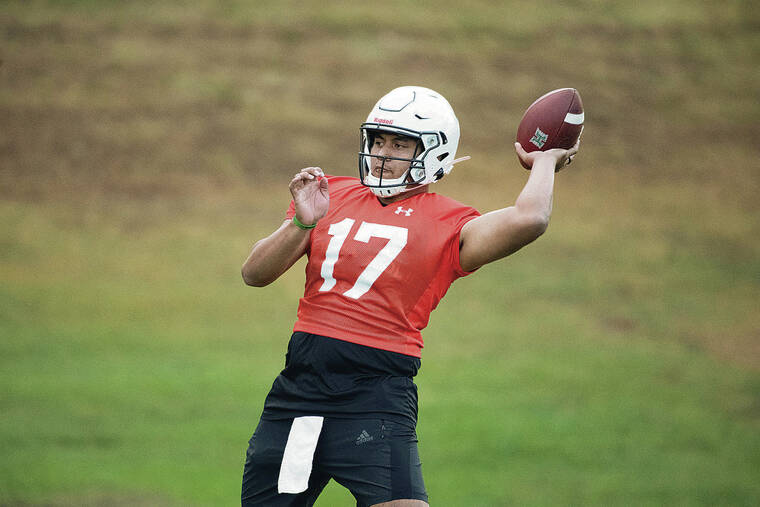
Mahalo for supporting Honolulu Star-Advertiser. Enjoy this free story!
There are five lifeguards with seemingly equal strength, athleticism, intelligence and training.
Which one is the volunteer?
Similarly, it is not always easy to pick from a starting lineup the University of Hawaii football player who is not on scholarship. Rich Miano, who played 11 NFL seasons? Miano was an accomplished diver at Kaiser High. Colt Brennan, a 2007 Heisman Trophy finalist? Brennan paid his own way in 2005, his first season as a Warrior. Ikaika Alama-Francis, the Detroit Lions’ second-round pick in 2007? Alama-Francis was a UH walk-on in basketball and football.
If recruiting is a football program’s lifeblood, as coaches often say, then walk-ons are platelets. Having too few can be problematic.
It would appear walk-ons are a luxury to Division I football programs on an 85-scholarship limit. Men’s volleyball, for instance, must spread the financial equivalent of 4.5 scholarships. Including the libero, there are seven starting positions. Baseball must divide the value of 11.7 scholarships among 27 players.
But while there have been arguments for lowering the scholarship limits for the 130 FBS (Division I-A) programs — the FCS (Division I-AA) is allowed 63 — with the financial and competitive stakes, coaches insist, the bigger the roster, the better. Depth is key in a collision sport where injuries are frequent. In the real world, a company loses three bookkeepers, it checks Indeed or places an ad in your favorite newspaper. When an FBS team loses two punters, the coaches are asking: “Anybody ever play rugby?” There is no waiver wire.
Which goes back to the importance of the walk-on players. They have helped stock the Warriors’ spring roster following the offseason’s departures. More walk-ons will join the Warriors this summer.
Until a few years ago, there was a clear separation between scholarship players and walk-ons. Because a meal plan was included in scholarships, walk-ons were not allowed free access to the buffet-style, training-table meals. Walk-ons would have to pay for that meal or wait for teammates to smuggle food in cups. The exception was on road trips, when walk-ons could participate in team meals.
But now, schools are allowed to provide meals and snacks for all players. All players also may receive money for the use of the name, image and likeness.
Still, walk-ons have financial obligations. They pay for their tuition, books, housing and other school expenses. Similar to non-student-athletes, walk-ons also are charged a student fee, which means they essentially pay to watch their own games. Ephraim Tuliloa knows the price of a dream.
Tuliloa is one of seven quarterbacks on the Warriors’ spring roster. Tuliloa and his wife have a 2-month-old daughter.
Tuliloa, who is a walk-on, leaves his home in Laie at 4:30 every morning. He is part of a car pool with UH teammates Ra Elkington and Nalu Emerson. He will attend football meetings, participate in practice or strength/conditioning, then attend classes and more meetings. At least three times a week, he will work at the Bobby Benson Center, a residential treatment center for youths in Kahuku. His shift goes from 3 p.m. to 11 p.m. Part of his paychecks are used to pay for school expenses.
Tuliloa embraces challenges. He grew up on Oahu’s North Shore and attended Punahou School. As a senior, his scholarship offers dried up after he suffered a shoulder injury. But football would have had to wait, anyway. Tuliloa was intent on serving a church mission.
He was assigned to predominately Spanish-speaking areas in Washington state’s Tri-Cities. One glitch. “I didn’t know any Spanish before that,” said Tuliloa, who learned the language during a six-week training session in Mexico City.
During his mission, he would awaken at 6 a.m., exercise, study and then go to his designated areas. “We went door-to-door knocking,” he said. “We met a lot of nice people. Some were kindly rejecting, but friendly nonetheless. We gave service or spread our message about Jesus Christ to those who wanted to hear it.”
After the mission, he attended New Mexico Military Institute for two seasons. “It’s pretty much run like a military school,” he recalled.
After getting married last year, the couple moved to Colorado Springs. Tuliloa worked full time for a sprinkler company. In the fall, he reached out to the UH coaches, who offered him a spot as a walk-on. At the time, the 6-foot-2 Tuliloa had ballooned to 280 pounds.
Angie Mafi, his mother-in-law, created a nutritional plan. He also went on an intensive training program. After Tuliloa enrolled at UH in January, strength-conditioning coordinator Kody Cooke was helpful in his fitness, improving the left-handed quarterback’s footwork and mobility.
“Right now, I’m in the high 230s,” Tuliloa said.
Of pursuing his dream, even on his own dime, Tuliloa said: “Definitely worth it.”
Source: Star







